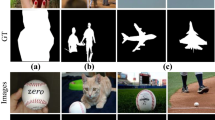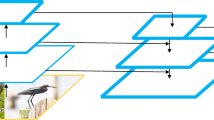Abstract
The multi-modality or multi-stream-based convolution neural network is the recent trend in saliency computation, which is receiving tremendous research interest. The previous models used modality-based independent fusion or cross-modality-based complementary fusion to find saliency that leads to incurring inconsistency or distribution loss of salient points and regions. Most existing models did not effectively utilize accurate localization of high-level semantic and contextual features. The proposed model collectively uses the above two methods and a precise deep localization model to target the abovementioned challenges. Specifically, CSA-Net comprises four essential features: non-complementarity, cross-complementary, intra-complementary, and deep localized improved high-level features. The designed \(2\times 3\) encoder and decoder streams produce these essential features and assure modality-specific saliency preservation. The cross and intra- complementary fusion are deeply guided by proposed novel, cross-complementary self-attention to produce fused saliency. The attention map is computed by two-stage additive fusion based on a Non-Local network. A novel, Optimal Selective Saliency, has been proposed to find two similar saliencies among three steam-wise saliencies. The experimental analysis demonstrates the effectiveness of the proposed \(2\times 3\) stream network and attention map. The experimental results show better performance in comparison with fourteen closely related state-of-the-art methods.








Similar content being viewed by others
References
Jerripothula KR, Cai J, Yuan J (2016) Image co-segmentation via saliency co-fusion. IEEE Trans Multimed 18(9):1896–1909
T. Durand, T. Mordan, N. Thome, M. Cord, in IEEE Conference on computer vision and pattern recognition (CVPR 2017) (2017)
B. Mahasseni, M. Lam, S. Todorovic, in Proceedings of the IEEE Conference on computer vision and pattern recognition (CVPR) (2017)
Shokri M, Harati A, Taba K (2020) Salient object detection in video using deep non-local neural networks. J Vis Commun Image Represent 68:102769
Zhang D, Meng D, Han J (2016) Co-saliency detection via a self-paced multiple-instance learning framework. IEEE Trans Pattern Anal Mach Intell 39(5):865–878
W. Wang, J. Shen, in Proceedings of the IEEE International Conference on computer vision (2017), pp. 2186–2194
Han J, Chen H, Liu N, Yan C, Li X (2017) Cnns-based rgb-d saliency detection via cross-view transfer and multiview fusion. IEEE Transon Cybern 48(11):3171–3183
Wang N, Gong X (2019) Adaptive fusion for rgb-d salient object detection. IEEE Access 7:55277–55284
N. Liu, N. Zhang, J. Han, in Proceedings of the IEEE/CVF Conference on computer vision and pattern recognition (2020), pp. 13,756–13,765
Wang A, Wang M, Li X, Mi Z, Zhou H (2017) A two-stage Bayesian integration framework for salient object detection on light field. Neural Process Lett 46(3):1083–1094
Chen H, Li Y (2019) Three-stream attention-aware network for rgb-d salient object detection. IEEE Trans Image Process 28(6):2825–2835
Fan DP, Lin Z, Zhang Z, Zhu M, Cheng MM (2020) Rethinking rgb-d salient object detection: Models, data sets, and large-scale benchmarks. IEEE Trans Neural Netw Learn Syst 2(5):2075–89
Liu Z, Li Q, Li W (2020) Deep layer guided network for salient object detection. Neurocomputing 372:55–63
K. Fu, D.P. Fan, G.P. Ji, Q. Zhao, in Proceedings of the IEEE/CVF Conference on computer vision and pattern recognition (2020), pp. 3052–3062
Wu Y, Liu Z, Zhou X (2020) Saliency detection using adversarial learning networks. J Vis Commun Image Represent 67:102761
Y. Hoshen, in Advances in Neural Information Processing Systems (2017), pp. 2698–2708
Y. Cheng, H. Fu, X. Wei, J. Xiao, X. Cao, in Proceedings of international conference on internet multimedia computing and service (ACM, 2014), p. 23
Cong R, Lei J, Zhang C, Huang Q, Cao X, Hou C (2016) Saliency detection for stereoscopic images based on depth confidence analysis and multiple cues fusion. IEEE Signal Process Lett 23(6):819–823
C. Zhu, G. Li, W. Wang, R. Wang, in IEEE International Conference on computer vision workshop (ICCVW) (2017)
D. Feng, N. Barnes, S. You, C. McCarthy, in Proceedings of the IEEE conference on computer vision and pattern recognition (2016), pp. 2343–2350
Zhou J, Ren Y, Yan Y, Pan L (2016) A multiple graph label propagation integration framework for salient object detection. Neural Process Lett 44(3):681–699
Song H, Liu Z, Du H, Sun G, Le Meur O, Ren T (2017) Depth-aware salient object detection and segmentation via multiscale discriminative saliency fusion and bootstrap learning. IEEE Trans Image Process 26(9):4204–4216
Kienzle W, Franz MO, Schölkopf B, Wichmann FA (2009) Center-surround patterns emerge as optimal predictors for human saccade targets. J Vis 9(5):7–7
W. Zhu, S. Liang, Y. Wei, J. Sun, in Proceedings of the IEEE conference on computer vision and pattern recognition (2014), pp. 2814–2821
Wang G, Zhang Y, Li J (2017) High-level background prior based salient object detection. J Vis Commun Image Represent 48:432–441
Zhang J, Sclaroff S (2016) Exploiting surroundedness for saliency detection: a boolean map approach. IEEE Trans Pattern Anal Mach Intell 38(5):889–902
Zhou X, Wang Y, Zhu Q, Xiao C, Lu X (2019) Ssg: superpixel segmentation and grabcut-based salient object segmentation. Vis Comput 35(3):385–398
Alexe B, Deselaers T, Ferrari V (2012) Measuring the objectness of image windows. IEEE Trans Pattern Anal Mach Intell 34(11):2189–2202
Zhong G, Liu R, Cao J, Su Z (2016) A generalized nonlocal mean framework with object-level cues for saliency detection. Vis Comput 32(5):611–623
Borji A, Cheng MM, Jiang H, Li J (2015) Salient object detection: a benchmark. IEEE Trans Image Process 24(12):5706–5722
Borji A, Cheng MM, Hou Q, Jiang H, Li J (2019) Salient object detection: a survey. Comput Vis Media. 5(2):117–150
Y. Niu, Y. Geng, X. Li, F. Liu, in 2012 IEEE Conference on computer vision and pattern recognition (IEEE, 2012), pp. 454–461
H. Peng, B. Li, W. Xiong, W. Hu, R. Ji, in European conference on computer vision (Springer, 2014), pp. 92–109
Singh SK, Srivastava R (2020) A robust salient object detection using edge enhanced global topographical saliency. Multimed Tools Appl 79(25):17885–17902
Singh SK, Srivastava R (2019) A novel probabilistic contrast-based complex salient object detection. J Math Imaging Vis 61(7):990–1006
Qu L, He S, Zhang J, Tian J, Tang Y, Yang Q (2017) Rgbd salient object detection via deep fusion. IEEE Trans Image Process 26(5):2274–2285
Liu Z, Shi S, Duan Q, Zhang W, Zhao P (2019) Salient object detection for rgb-d image by single stream recurrent convolution neural network. Neurocomputing 363:46–57
H. Chen, Y. Li, in Proceedings of the IEEE conference on computer vision and pattern recognition (2018), pp. 3051–3060
J.X. Zhao, Y. Cao, D.P. Fan, M.M. Cheng, X.Y. Li, L. Zhang, in Proceedings of the IEEE Conference on computer vision and pattern recognition (2019), pp. 3927–3936
Y. Piao, W. Ji, J. Li, M. Zhang, H. Lu, in Proceedings of the IEEE/CVF International Conference on computer vision (2019), pp. 7254–7263
X. Wang, R. Girshick, A. Gupta, K. He, in Proceedings of the IEEE conference on computer vision and pattern recognition (2018), pp. 7794–7803
Dabov K, Foi A, Katkovnik V, Egiazarian K (2007) Image denoising by sparse 3-d transform-domain collaborative filtering. IEEE Trans Image Process 16(8):2080–2095
Y. Cao, J. Xu, S. Lin, F. Wei, H. Hu, in Proceedings of the IEEE/CVF International Conference on computer vision workshops (2019), pp. 0–0
C. Szegedy, W. Liu, Y. Jia, P. Sermanet, S. Reed, D. Anguelov, D. Erhan, V. Vanhoucke, A. Rabinovich, in Proceedings of the IEEE conference on computer vision and pattern recognition (2015), pp. 1–9
Al Azzeh J, Alhatamleh H, Alqadi ZA, Abuzalata MK (2016) Creating a color map to be used to convert a gray image to color image. Int J Comput Appl 153(2):31–34
Q. Hou, M.M. Cheng, X. Hu, A. Borji, Z. Tu, P.H. Torr, in Proceedings of the IEEE Conference on computer vision and pattern recognition (2017), pp. 3203–3212
G. Huang, Z. Liu, L. Van Der Maaten, K.Q. Weinberger, in Proceedings of the IEEE conference on computer vision and pattern recognition (2017), pp. 4700–4708
C. Zhu, G. Li, in Proceedings of the IEEE International Conference on computer vision workshops (2017), pp. 3008–3014
R. Ju, L. Ge, W. Geng, T. Ren, G. Wu, in 2014 IEEE international conference on image processing (ICIP) (IEEE, 2014), pp. 1115–1119
N. Li, J. Ye, Y. Ji, H. Ling, J. Yu, in Proceedings of the IEEE Conference on computer vision and pattern recognition (2014), pp. 2806–2813
D.P. Kingma, J. Ba, Adam A method for stochastic optimization. arXiv preprint arXiv:1412.6980 (2014)
D.P. Fan, M.M. Cheng, Y. Liu, T. Li, A. Borji, in Proceedings of the IEEE international conference on computer vision (2017), pp. 4548–4557
F. Perazzi, P. Krähenbühl, Y. Pritch, A. Hornung, in Computer vision and pattern recognition (CVPR), 2012 IEEE Conference on (IEEE, 2012), pp. 733–740
D.P. Fan, C. Gong, Y. Cao, B. Ren, M.M. Cheng, A. Borji, Enhanced-alignment measure for binary foreground map evaluation. arXiv preprint arXiv:1805.10421 (2018)
Author information
Authors and Affiliations
Corresponding author
Ethics declarations
Conflict of interest
The authors have no relevant financial or non-financial interests to disclose.
Additional information
Publisher's Note
Springer Nature remains neutral with regard to jurisdictional claims in published maps and institutional affiliations.
Rights and permissions
About this article
Cite this article
Singh, S.K., Srivastava, R. CSA-Net: Deep Cross-Complementary Self Attention and Modality-Specific Preservation for Saliency Detection. Neural Process Lett 54, 5587–5613 (2022). https://doi.org/10.1007/s11063-022-10875-w
Accepted:
Published:
Issue Date:
DOI: https://doi.org/10.1007/s11063-022-10875-w




